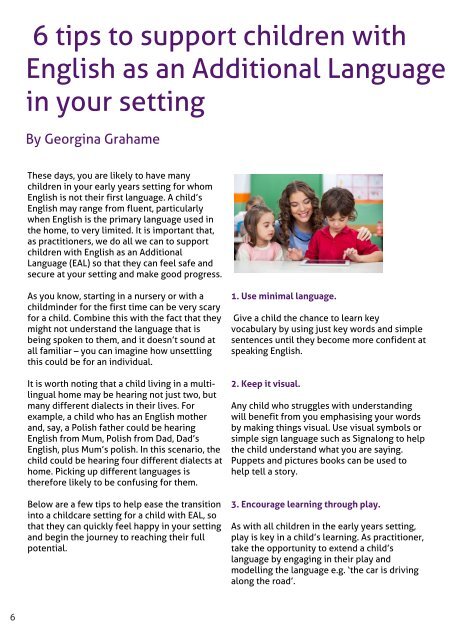volume-three-january-2015
Create successful ePaper yourself
Turn your PDF publications into a flip-book with our unique Google optimized e-Paper software.
6 tips to support children with<br />
English as an Additional Language<br />
in your setting<br />
By Georgina Grahame<br />
These days, you are likely to have many<br />
children in your early years setting for whom<br />
English is not their first language. A child’s<br />
English may range from fluent, particularly<br />
when English is the primary language used in<br />
the home, to very limited. It is important that,<br />
as practitioners, we do all we can to support<br />
children with English as an Additional<br />
Language (EAL) so that they can feel safe and<br />
secure at your setting and make good progress.<br />
As you know, starting in a nursery or with a<br />
childminder for the first time can be very scary<br />
for a child. Combine this with the fact that they<br />
might not understand the language that is<br />
being spoken to them, and it doesn’t sound at<br />
all familiar – you can imagine how unsettling<br />
this could be for an individual.<br />
It is worth noting that a child living in a multilingual<br />
home may be hearing not just two, but<br />
many different dialects in their lives. For<br />
example, a child who has an English mother<br />
and, say, a Polish father could be hearing<br />
English from Mum, Polish from Dad, Dad’s<br />
English, plus Mum’s polish. In this scenario, the<br />
child could be hearing four different dialects at<br />
home. Picking up different languages is<br />
therefore likely to be confusing for them.<br />
Below are a few tips to help ease the transition<br />
into a childcare setting for a child with EAL, so<br />
that they can quickly feel happy in your setting<br />
and begin the journey to reaching their full<br />
potential.<br />
1. Use minimal language.<br />
Give a child the chance to learn key<br />
vocabulary by using just key words and simple<br />
sentences until they become more confident at<br />
speaking English.<br />
2. Keep it visual.<br />
Any child who struggles with understanding<br />
will benefit from you emphasising your words<br />
by making things visual. Use visual symbols or<br />
simple sign language such as Signalong to help<br />
the child understand what you are saying.<br />
Puppets and pictures books can be used to<br />
help tell a story.<br />
3. Encourage learning through play.<br />
As with all children in the early years setting,<br />
play is key in a child’s learning. As practitioner,<br />
take the opportunity to extend a child’s<br />
language by engaging in their play and<br />
modelling the language e.g. ‘the car is driving<br />
along the road’.<br />
6

















